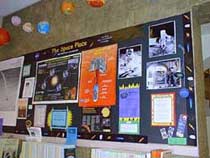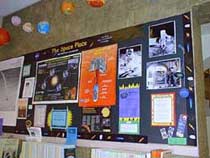Disclaimer: This material is being kept online for historical purposes. Though accurate at the time of publication, it is no longer being updated. The page may contain broken links or outdated information, and parts may not function in current web browsers.
 Let's go to the Moon!
Let's go to the Moon!
No human has walked on the Moon since the Apollo 17 mission in December 1972. This time, though, the astronauts will stay much longer than the few days of the Apollo 17 mission. So now, NASA's Exploration Technology Development Program is working on everything that will be needed to make the Moon a place where a crew of astronauts can live for months.
Explorers from Earth will have to build their own habitat, or home. Their home must protect them like no home on Earth would ever need to do. Why?
There is no air on the Moon. And the temperature varies from 387 degrees Fahrenheit BELOW zero (-233 Celsius) at night to 253 degrees Fahrenheit ABOVE zero (123 Celsius) in the day. Tiny micro-meteoroids (space rocks) rain down on the Moon's surface. And no atmosphere means no protection from the Sun's harsh radiation.
So a Moon habitat for humans will have to be very tough and very sturdy. It will have to be air tight, so the inside can be pumped up with breathable air without exploding or leaking. The habitat will have to be cooled during the Moon day and heated during the Moon night. It will need a water recycling system, a power generating system, and food storage and preparation facilities.
The materials to build the Moon habitat should be lightweight, since they will have to be boosted out of Earth's gravitational field using rockets.The habitat will have to be sent to the Moon in pieces and assembled by the explorers once they arrive. So it should be easy to put together, since the Moon explorers will be working in space suits.
NASA's Exploration Technology Development Program is working on designs for a Moon habitat. The light-weight experimental house shown here is inflatable, so would not take up much space until needed.
As with any Moon habitat, it must have an airlock. The airlock is a small room between the door to the outside and the door to the inside. Both doors must close very tight and not leak any air. Before the astronaut opens the outside door, the inside door must be closed. The astronaut enters the airlock and closes the outside door. Then the airlock is pumped full of air. Only then can the astronaut open the inside door to enter the habitat. Leaving the habitat, the astronaut (in a spacesuit, of course), steps into the airlock with the outside door closed. The inside door is then closed and all the air pumped out of the airlock, making it a vacuum, just like the outside. The astronaut opens the outside door and steps outside.

You can be a Moon explorer too. Practice by building your own Moon habitat. Pretend you are an astronaut working with your team mates on the Moon to build your new home.
Materials you will need to build one Moon habitat:
- 148 sheets of newspaper (use a paper with large pages—tabloid size is too small—and use the full square spread)
- Pencil
- Masking or packaging tape
- Scissors
- Yardstick
- Stapler (heavy-duty, if available)
- Bed sheet, colored tissue paper, or more newspapers for "walls" (optional)
- White glue or glue stick (optional)
Construct the Moon habitat:
Use four sheets of newspaper to build each log. Lay the sheets out flat, one on top of the other.
Set the pencil in the corner and roll across on the diagonal. Use the pencil to help you get started, and then remove the pencil. Roll evenly, but don't try to make the logs as thin as the pencil. When you get to the opposite corner of the paper, you'll have a tube or log. Tape the log shut.
Staple three logs together to create a triangle. Repeat until you have five triangles.
Staple the five triangles to each other at their bottom corners. Add connecting logs across the top.
Staple the remaining five logs together at the center to make a star.
Then raise the five connected triangles, or walls, off the floor and staple the ends together to form a five-sided (pentagonal) structure. It helps to have one person hold up the walls while another person staples.
Now staple the free ends of the star to the junctions of the triangles on the top of the base, and the structure will stand by itself.


Repeat this process until you have 37 logs. Then trim the ends a bit, making sure all the logs are the same length. They will be around 30 inches long.
Now you will need a big, open space in which to construct the habitat.




Construct the "airlock:"
You should have 12 logs left. These will make the "airlock." Staple three logs together to make another triangle (red in above drawing). Use two more logs (green) to attach the base of this triangle to one of the base logs of the "habitat." This triangle becomes the airlock door.
Using three more logs (blue), create a square by stapling them around the "door." The side logs will be a bit too long, so cut them off to make a square.
Use two more logs (yellow) to make a triangle to support the airlock at the top. To do this, staple the ends to the two top corners of the square and staple the other ends together where the triangles meet on the habitat.
Use the last two logs (purple) to stabilize the airlock as shown in the drawing.
Fill in with solid walls (optional):
You can give the structure "solid" walls by either carefully draping a sheet or two over it or by covering each section with tissue paper or newspaper. To do this, smear glue onto the logs and gently press pieces of colored tissue paper or newspaper onto the triangles. Don't forget to leave a door! You can rip or cut off the loose edges of the tissue paper.
Don't forget the NASA logo! Print it, cut it out, and pin or glue it to the outside of your Moon habitat.









